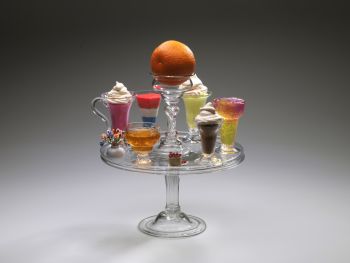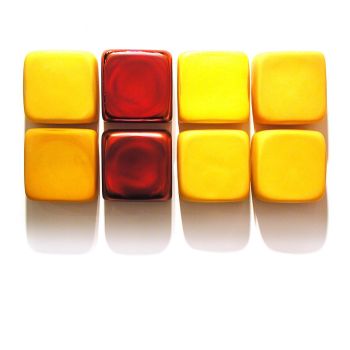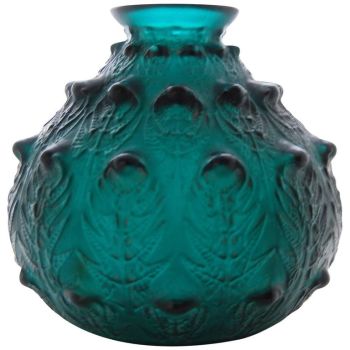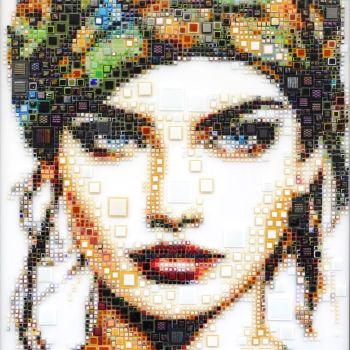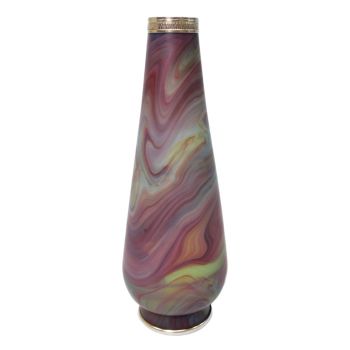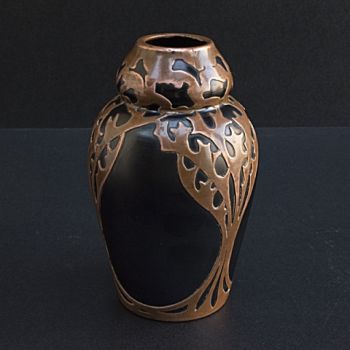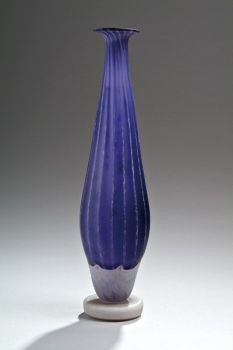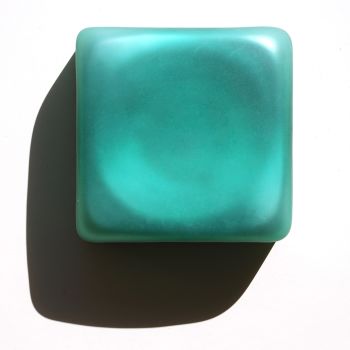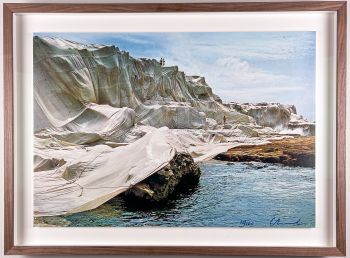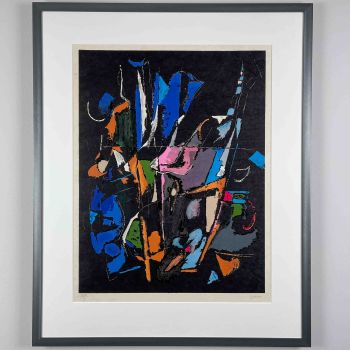A largest size glass art-object "Pajunlehti" or "Willowleaf" in unusual colour light-brown, model KF 1960 - 1965
Kaj Franck
Glass
4 ⨯ 24 ⨯ 9 cm
ConditionVery good
€ 750
Van Kerkhoff Art
- About the artworkA free blown, flared, cut and polished light brown and clear cased glass art-object "Pajunlehti" or "Willowleaf", model KF 210. Designed by Kaj Franck in 1954 and executed by the Nuutajärvi-Notsjö glassworks circa 1960.
These art-objects were made in three different size-ranges and several colours between 1954 and 1963. This being a largest size example in a unusual light brown colour. The same colour used in the Nuutajärvi-Notsjö glassworks for one of the "Prisma" variants.
This Wilowleaf is etched-signed underneath the base. The etching has faded though and only K. F. remains readable. Either it was signed this way or the rest of the designers name has faded. The piece is in good condition, scratches underneath the base but no cracks or chips.
About Kaj Franck
Kaj Franck (Vyborg, Finland 1911 – Santorini, Greece 1989) was an influential Finnish designer and leading figure in Finnish art-world between 1940-1980.
Born in 1911 on the Finnish Russian border in a family of architects (his grandfather was director of the famous Arabia Ceramics factory) of Finnish-German-Swedish decent.
He attended the furniture department of Taideteollinen korkeakoulu (todays Aalto university school of Arts, Design and Architecture) in Helsinki.
After his studies he worked as a freelance designer until he joined Arabia as a designer in 1945. In 1950 he became Arabia’s Artistic Director. He also designed glass-objects for Iittala between 1946 and 1950 and between 1950 and 1976 for Nuutajärvi-Notsjö glassworks.
From 1945 onwards he worked as and educator at Taideteollinen korkeakoulu and he became the institute's Artistic Director in 1960.
His modernist designs in everyday tableware glass are considered to be a revolution and classic Finnish design object (most notably his Kilta tableware and Kartio glassware).
He is often referred to as “the conscience of Finnish design”, moderation, ecology and equality were Franck’s principles. He strove to minimise the number of everyday objects we need in our lives, drawing attention to the sustainability and life cycle of products.
Kay Franck’s designs are in collections of numerous museums all over the world. Among others: Design Museum Helsinki, Museum of Modern Art, New York, Stedelijk Museum Amsterdam and The British Museum, London. He was a recipient of many prizes. Most notably the Lunning prize in 1955, a “Grand prix” and several “Gold medals” at the Triennale di Milano.
Today his name is used for the prestigious “The Kaj Franck Design Prize” annually awarded by the Finnish Design Forum.
Execution
Nuutajärvi-Notsjö glassworks, Finland circa 1960
Marked
Etched-signed underneath the base. The etching has faded though and only K. F. remains readable. Either it was signed this way or the rest of the designers name has faded.
Condition
This art-object is in good vintage condition, some minor scratches and wear consistent with age and use. No chips or cracks.
Literature
Marianne Aav (ed.), Kaj Franck, Universal Forms, p.322
Dimensions
H. 4.9 cm
W. 24.9 cm
D. 9.8 cm
Weight 843 grams - About the artist
Finnish ceramic and glass designer Kaj Franck (1911-1989) realized a powerful truth in his distinguished career: simple is beautiful. Despite the world moving at an ever-fastening pace, from one decade to another, that simple truth remains. Franck’s inspiration and principles began a tradition in Finnish design, which is still alive and strong today. His best-known works are Iittala Teema and Kartio series, and his heritage is a part of every Finnish home.
"I want to make use of objects that are so obvious that they are not noticeable”, Kaj Franck defined his own work. His designs catered to basic human needs while serving them tools with properties of everyday objects. Franck was also interested in low-cost mass production and shunned materialism, throwaway culture and showing off. Franck’s world consisted of the basic mathematical shapes and simple forms, decorated only with strong colours.
The starting point of Franck's work was practicality combined with beauty. Although it seems self-evident today, in his own time his thoughts were radical. Franck separated styles and fashion trends from tradition and gave it a whole new meaning. In the period of 1952-53, Franck showed that dinnerware does not need to be overly complex with the release of the Kilta series as strong statement – it was a novel idea that everyone was able to do table settings according to their own needs.
Franck began his designs by focusing on the idea or underlying concept, not the shape. This emphasis on the idea aspect of design was also carried to his work as a teacher and later as an artistic director at the University of Art and Design in Helsinki. Franck was also one of the first advocates of recycling, and he has often been called the "conscience of Finnish design”. Franck won many awards in his distinguished career and became internationally famous. Today, the Kaj Franck Award is Finland's most prestigious design recognition.
Are you interested in buying this artwork?
Artwork details
Related artworks
- 1 - 4 / 10
- 1 - 4 / 24
Frères Daum
Daum Nancy – “Paysage Soleil Couchant” vase with two applied handles1900 - 1910
Price on requestAntiques Emporium
Unknown artist
François-Théodore Legras – Tall “Fleurs de Pommier” apple blossoms vase1900 - 1909
Price on requestAntiques Emporium
1 - 4 / 24Unknown artist
Salver or Tazza with orange glass, jelly and custard glasses.1750 - 1755
Price on requestPeter Korf de Gidts - Antiquairs
René Lalique
A very rare deep green ‘Fougeres’ Vase designed by R. Lalique1912
€ 8.950Lennart Booij Fine Art and Rare Items
 Curated by
Curated bySilla Scheepens
Frères Daum
Daum Nancy – “Paysage Soleil Couchant” vase with two applied handles1900 - 1910
Price on requestAntiques Emporium
Unknown artist
François-Théodore Legras – Tall “Fleurs de Pommier” apple blossoms vase1900 - 1909
Price on requestAntiques Emporium
1 - 4 / 24- 1 - 4 / 12
















































